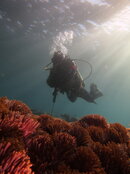To stay neutrally buoyant, yes. It's all about opposing forces: ying and yang.
If your legs are below your head, your kicking propels you up as well as forward. In order to stay neutral, you have to make yourself negative. Once you stop kicking, you lose that upward momentum and so you have to add air or scull. Once you start kicking again, you have to get negative again to compensate for the upward thrust.
I'm not sure whether people become negatively buoyant to compensate for not being horizontal when they fin or they add a vertical component of thrust to their finning to compensate for being negatively buoyant. I suspect it is the latter. Either way, if you are over-weighted and not neutrally buoyant once you stop finning you will start sink. You either have to start finning again or start sculling with your hands.
I see this occasionally when diving on the charter boat. The finning motion looks a bit like riding a bike. The simple solution is to add air to your BCD rather than finning upward and get in the horizontal position when you are moving.
You don't have to be horizontal to achieve neutral buoyancy when you are stationary. People often hang vertically in the water during their safety stop. Photographers often have a non horizontal trim when shooting photos.
Two major forces affect your trim and buoyancy. One is the force of gravity that pulls you down and can be thought to act through your centre of gravity or centre of mass. The other is the buoyancy force that pushes you up and can be thought to act through your centre of buoyancy or your centre of volume. If the two forces are equal you will be neutrally buoyant in the water.
If the two forces are equal but not aligned then while you won't sink, you will rotate until the centre of gravity and centre of buoyancy are vertically aligned. Often the centre of gravity is further toward the feet than the centre of buoyancy so divers rotate so their feet fall and their head is raised. You can vary the position of your centre of mass by adding or moving weights to different locations on your body, by adjusting the position of your tank or by moving your arms and legs in and out. Similarly you can vary the position of your centre of buoyancy by moving your arms and legs in and out or by varying the volume of air in your lungs. There are a number of different body orientations and shapes that will result in the two forces being aligned.
If the two forces are not equal but aligned you sink or float but won't rotate.
I find cranking my head forward while horizontal uncomfortable and I tend to use more air. If I'm stationary I'm normally looking at something or for someone so I like to have my trim adjusted so that my body is say 30-45 degrees to the horizontal and my lower legs are bent upward. Once you are neutrally buoyant it takes little effort to kick off and remain horizontal as you fin forward.





